The research and development tax incentive is in “free fall”, the Opposition has said, with business R&D spending falling by nearly 30 percent in just three years.
The federal budget showed the government’s targets for business expenditure on research and development has fallen by $5.3 billion since 2017.
The target for R&D expenditure registered by companies with the department to claim the tax incentive through annual tax returns was listed at $13.9 billion in the 2019-20 budget. That’s down from $16 billion in last year’s budget and $19.2 billion in the 2017-18 budget.

That equates to a drop of nearly 30 percent in just three years, accompanied by a $1.35 billion cut to the research and development tax incentive over the forward estimates, quietly revealed in the budget but not flagged by the government.
Treasury has denied that there has been a cut to the scheme, saying that the reduced forecast reflects changes to company tax rates instead.
Shadow innovation minister Kim Carr said that research and development has been “sent into a downward spiral under the Liberals”.
“Scott Morrison and his government have sent the R&D tax incentive into free fall. The budget also cut the Liberals’ flagship programs of NISA, with close to $50 million cut from the Entrepreneurs’ programme and the Industry Growth Centres,” Senator Carr said.
“This government has turned its back on innovation, with innovation becoming a dirty word in name and deed.”
The lack of funding or commitments for the tech sector in the federal budget was criticised by Senator Carr.
“This is a measure of the government’s lack of vision, and lack of commitment to Australian industry and Australian jobs. But all they have done is cut support to Australian industry even further in this budget, with a new cut of close to $50 million,” he said.
“The Minister for Industry, Science and Technology is meant to be the champion for this sector and new jobs. But Karen Andrews couldn’t even get the word innovation into the Treasurer’s speech. As the sixth industry and science minister in six years, it is hardly surprising that this government has no plan for the jobs of the future.”
In her budget press release, Ms Andrews said it “demonstrates the Morrison government’s commitment to new industries and skills, while also ensuring we support traditional Australian industries and jobs, to further strengthen our economy”.
The minister pointed to near-$20 million funding for space infrastructure and $3.4 million for efforts aiming at improving gender diversity in STEM as the main policy areas for the sector.
“Our commitment to new industries and skills, while ensuring we support traditional Australian industries and jobs, is part of our plan for a stronger economy,” Ms Andrews said.
The government also took the scissors to the research and development tax incentive itself again, shedding a further $1.35 billion from the popular scheme over the forward estimates. The scheme is currently in limbo, with the government yet to reveal how it plans to move ahead with its changes to the scheme after they were put on hold earlier this year.
Treasury has denied that any changes or cuts have been made to the RDTI, saying that the figures show a change in the forecast of the expense component of the scheme over the forward estimates. It said that this is a reflection of the outlook based on company tax returns, and is the result of the acceleration of company tax rates.
Under government amendments, the size of the R&D return will be directly linked with a company’s applicable company tax rate, but these changes have not yet been passed by the Parliament.
Treasury said the figures “do not reflect any of the costs associated with the non-refundable tax offset”.
Do you know more? Contact James Riley via Email.

